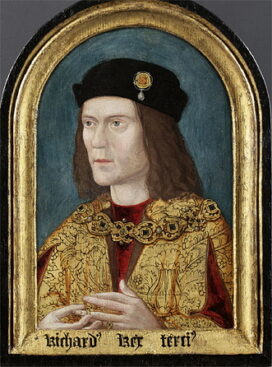Facts about Richard
Richard III Biography
Richard III was King of England for just over two years in the 15th century, but the debate about him continues: Shall he be remembered as a visionary reformer and brilliant administrator, or as an ambitious usurper and ruthless murderer? The son of Richard, Duke of York, young Richard was named Duke of Gloucester when his brother was crowned King Edward IV in 1461. Richard spent most of Edward’s reign in the northern parts of the realm, earning a reputation as an able administrator and commander of Yorkist forces during the War of the Roses against King Henry VI. Edward IV died in 1483 and Richard involved himself in a power struggle with Edward’s queen, Elizabeth Woodville (or Wydville), whose son, Edward V, was the rightful heir — but was too young to rule. Richard managed to imprison Edward V and his younger brother, Richard, in the Tower of London, and the two boys were never seen again. An act of Parliament declared the nephews illegitimate (supposedly due to an earlier, secret marriage of Edward IV that invalidated his marriage to Elizabeth), and Richard III was crowned King of England on 6 July 1483. Apparently good at governing, Richard III is known to have instituted many positive legal reforms. But his hold on power was tenuous, thanks in large part to the widely-held suspicion that he had ordered the murders of his nephews and usurped the throne. In the end, Richard III was killed on 22 August 1485 on the battlefield at Bosworth by the forces of Henry Tudor, who then took the throne as Henry VII. For centuries Richard III was known as the evil “Crouchback,” a deformed and malevolent ruler depicted by later propagandists and, most famously, in William Shakespeare‘s 1592 play The Life and Death of Richard III. These days loyal Ricardians work to repair Richard’s wicked reputation, but the traditional view is that Richard, while not as evil as Tudor historians said, was probably responsible for removing his nephews from the royal line. In 2013, experts from the University of Leicester announced that DNA testing had confirmed that a skeleton found underneath a parking lot in Leicester, England was indeed the body of Richard III. Two years later, in March of 2015, Richard III’s body was interred at Leicester Cathedral
Extra credit
One of the rumors spread about Richard III was that he had crooked shoulders and a withered arm, but there doesn’t seem to be any contemporary evidence to prove it… Shakespeare’s Richard III opens with the lines, “Now is the winter of our discontent / made glorious summer by this sun of York.” Act 5, scene 4 includes his famous exclamation, “A horse, a horse, my kingdom for a horse!”

